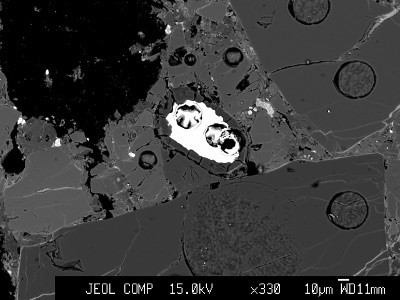

A team of scientists working in Antarctica have found a meteorite containing pieces of the precious stone opal, providing further proof that asteroids in our solar system likely received their water from collisions with water-carrying meteorites.
The team led by geochemistry professor Hilary Downes of Birkbeck College London determined that the meteorite named EET 83309, composed of thousands of pieces of rock and minerals, had impacted with an asteroid billions of years ago, whereupon the Sun’s radiation had over time transformed the water in its structure to crystallized opal.
“The pieces of opal we have found are either broken fragments or they are replacing other minerals,” says Downes, whose findings were recently presented at the 2016 National Astronomy Meeting in Nottingham, U.K. “Our evidence shows that the opal formed before the meteorite was blasted off from the surface of the parent asteroid and sent into space, eventually to land on Earth in Antarctica.”
This is the first evidence of opal, which is made of up to 30 per cent water, to have formed on the surface of an asteroid and provides another clue to the mystery of how the water that makes up the Earth’s oceans actually got here in the first place.
Competing theories have it that water was either part of Earth’s structure from its initial formation or that it was brought here by asteroids or comets through a multitude of impacts with the Earth’s surface, during a period known as the late heavy bombardment approximately 800 million years after the Earth’s formation.
And although both asteroids and comets are known to contain water, experts are now less convinced of the theory that comets brought us our water, in part due to findings from the European Space Agency’s Rosetta spacecraft which successfully orbited and landed a probe on a comet named 67P/Churyumov-Gerasimenko. Rosetta’s analyses of the comet’s gases determined that its water has a different “trademark” ratio of deuterium to hydrogen than water found on Earth, making it very unlikely that comets similar to 67P could have been the source of Earth’s water.
Ever heard of “Porch Pirates”?
He just stole your package right from your front door. What do you do?
Click here for the answer…
___________________________________________________________________________________________________________
The idea that asteroids were the primary source of Earth’s water also took a hit last year when scientists studying lava rocks from Baffin Island in northern Canada found glass crystals containing tiny droplets of water embedded in the rock. Researchers believe that this water can trace its origins to the water-soaked dust grains that were present in our solar system at the time of Earth’s formation, subsequently buried deep within the Earth’s mantle only to rise to the surface in lava flows such as those preserved on Baffin Island.
The findings of opal in the Antarctic meteorite are just the second such discovery, after scientists investigating the Tagish Lake meteorite which landed on Tagish Lake in Northern BC on January 18, 2000, found opal-like crystals in the rock, giving evidence that water must have been present in the meteorite.
The new results give further insight into the water content on asteroids. “This is more evidence that meteorites and asteroids can carry large amounts of water ice,” says Downes. “Although we rightly worry about the consequences of the impact of large asteroid, billions of years ago they may have brought the water to the Earth and helped it become the world teeming with life that we live in today.”
Comment
One thought on “Antarctic meteorite found containing opal, scientists say”
Leave a Reply
You must be logged in to post a comment.




 Share
Share Tweet
Tweet Share
Share




I thought opal was a semi-precious stone, rather than a precious stone, n’est ce pas? Does this mean we can look forward to opal wedding rings?